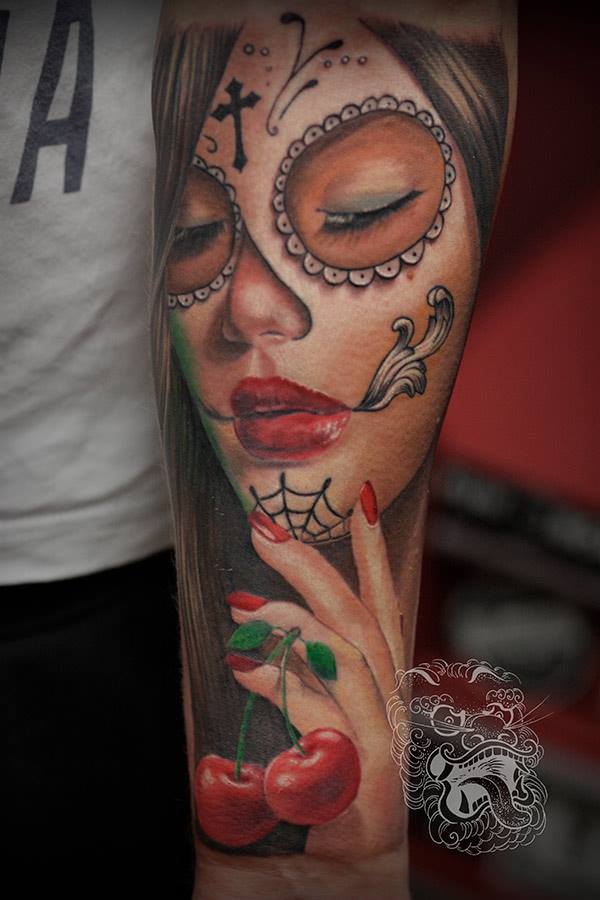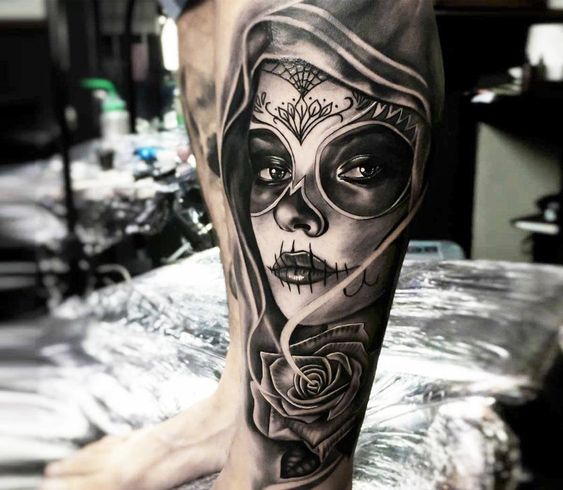In the world of tattoo art, certain motifs have become iconic, transcending cultural boundaries and capturing the imagination of artists and enthusiasts alike. Among these, La Catrina, a symbol of Mexican culture and tradition, has emerged as a powerful and visually striking design choice. This article delves into the captivating realm of La Catrina tattoo designs, exploring their historical context, artistic interpretations, and the profound meanings they hold for those who wear them.
The Legacy of La Catrina: A Cultural Icon

La Catrina, a stylized skeleton dressed in elegant attire, is an enduring symbol of Mexico’s Día de los Muertos (Day of the Dead) celebrations. Created by the renowned Mexican printmaker and cartoonist José Guadalupe Posada in the early 20th century, La Catrina has evolved from a satirical political commentary to a revered cultural emblem.
Posada's original work, known as "La Calavera Garbancera," depicted a female skeleton dressed in the finest European-inspired clothing, mocking the pretensions of the Mexican upper class who denied their indigenous heritage. Over time, this satirical figure transformed into an elegant and sophisticated representation of death, embodying the Mexican philosophy of embracing mortality with grace and humor.
The widespread popularity of La Catrina can be attributed to her embodiment of Mexico's unique blend of indigenous and Spanish colonial influences. Her image has become a testament to the nation's rich cultural heritage, serving as a reminder of the importance of honoring and celebrating life and those who have passed on.
Artistic Interpretations: La Catrina Tattoo Styles

La Catrina tattoos offer a vast array of artistic interpretations, each reflecting the unique vision of the artist and the wearer. From intricate blackwork to vibrant color pieces, the possibilities are endless, allowing for a deeply personal expression of this cultural icon.
Traditional Black and Gray Realism
For those seeking a classic and elegant portrayal, traditional black and gray realism is a popular choice. This style emphasizes La Catrina’s intricate skeletal structure, often highlighting the fine details of her bones and the subtle shading that adds depth to her visage. The result is a sophisticated and understated tattoo that pays homage to the original Posada creation.
| Style | Description |
|---|---|
| Black and Gray | Subtle shading, detailed skeletal structure |
| Traditional Realism | Realistic portraiture, attention to facial features |

Colorful Neo-Traditionalism
Neo-traditional tattoos bring a vibrant twist to the La Catrina design. Artists often incorporate bold colors, floral motifs, and intricate patterns, transforming La Catrina into a lively and celebratory figure. This style captures the spirit of Día de los Muertos, where bright colors and festive decorations are a central part of the tradition.
Watercolor and Abstract Interpretations
Some artists take a more abstract approach, using watercolor techniques or unconventional styles to create unique La Catrina tattoos. These designs may feature a blurred or impressionistic take on the skeleton, with soft edges and a dreamlike quality. This style allows for a highly personalized interpretation, often incorporating symbolic elements significant to the wearer.
The Symbolic Meaning Behind La Catrina Tattoos
Beyond their aesthetic appeal, La Catrina tattoos hold deep symbolic meanings for those who choose to adorn their bodies with this iconic image. Here are some of the most prevalent interpretations:
Embracing Mortality
At its core, La Catrina symbolizes the acceptance and celebration of death as an integral part of life. By embracing this skeleton figure, tattoo wearers embrace the idea that death is not to be feared but rather respected and acknowledged. It serves as a reminder to live life to the fullest and appreciate the preciousness of every moment.
Cultural Pride and Heritage
For individuals with Mexican heritage, La Catrina tattoos are a powerful way to express cultural pride and connection to their roots. The image of La Catrina, with its rich historical and cultural context, becomes a personal statement, honoring the traditions and values passed down through generations.
Remembrance and Memorialization
La Catrina tattoos are often chosen as a way to memorialize loved ones who have passed away. The skeleton’s elegant and dignified presence serves as a reminder of the beauty and resilience of the human spirit, even in the face of mortality. It is a way to keep the memory of a departed soul alive and close to the heart.
Performance and Expression: La Catrina as a Cultural Ambassador
La Catrina’s iconic status extends beyond the realm of tattoos, as she has become a cultural ambassador, representing Mexico’s vibrant traditions and unique perspective on death and life. During Día de los Muertos celebrations, many people dress up as La Catrina, donning elegant skeletal makeup and elaborate costumes.
This tradition not only pays homage to Posada's original creation but also serves as a powerful statement of cultural pride and unity. La Catrina, in her various artistic interpretations, becomes a symbol of resilience, a reminder that even in the face of adversity, beauty and joy can prevail.
The Global Appeal of La Catrina
The influence of La Catrina has transcended borders, with her image becoming increasingly popular in tattoo art worldwide. This global appeal can be attributed to the universal themes of mortality, cultural pride, and the celebration of life that La Catrina embodies. She has become a symbol that transcends language and cultural barriers, uniting people through a shared appreciation for the beauty of life and the acceptance of death.
Conclusion: A Timeless Icon, A Personal Journey

La Catrina tattoo designs offer a captivating blend of historical context, artistic expression, and profound personal meanings. Whether chosen as a tribute to Mexican heritage, a reminder to embrace life’s fragility, or a memorial to a loved one, La Catrina tattoos stand as a testament to the power of art to convey complex emotions and ideas.
As an enduring symbol, La Catrina continues to inspire and captivate, inviting artists and enthusiasts to explore the rich tapestry of Mexican culture and the universal themes it embodies. Through the intricate lines and vibrant colors of these tattoos, the spirit of La Catrina lives on, reminding us all of the beauty that lies in the acceptance of our shared mortality.
What is the significance of La Catrina in Mexican culture?
+La Catrina symbolizes the Mexican attitude towards death and life. It represents the acceptance and celebration of mortality, reflecting the belief that death should be acknowledged with grace and humor. This icon is a central figure in Día de los Muertos, a Mexican holiday where families honor their deceased loved ones.
How has La Catrina evolved from its original satirical purpose to a cultural symbol?
+La Catrina’s evolution is a fascinating journey. Originally created as a satirical figure by José Guadalupe Posada, mocking the pretensions of the Mexican elite, it has since transformed into an elegant and sophisticated representation of death. Over time, its image has become intertwined with Mexican culture, symbolizing the nation’s unique blend of indigenous and Spanish colonial influences.
What are some common styles used in La Catrina tattoos, and what do they represent?
+La Catrina tattoos come in various styles, each with its own interpretation. Traditional black and gray realism emphasizes the skeletal structure, representing a classic and understated approach. Colorful neo-traditional tattoos bring a festive and vibrant twist, capturing the spirit of Día de los Muertos. Watercolor and abstract interpretations offer a more personalized and symbolic take, often incorporating meaningful elements significant to the wearer.